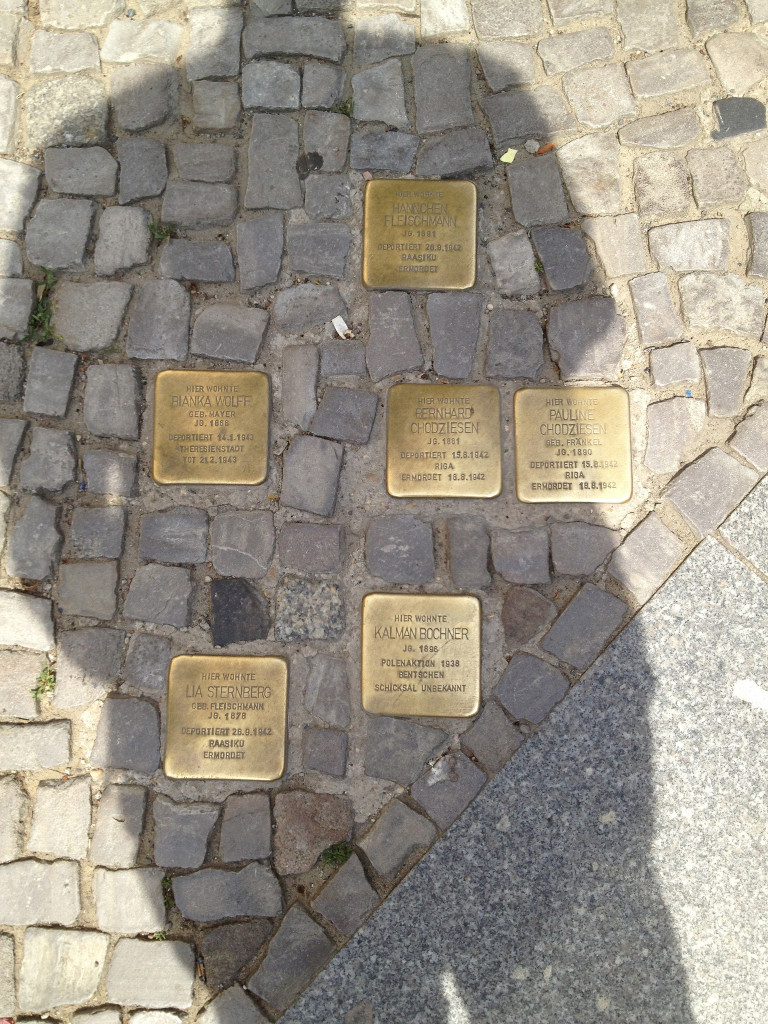Stumbling in Berlin
 As we wandered along the pleasant cobblestone streets of Berlin this summer, enjoying our vacation rest and pondering the many layers of meaning that this city holds for anyone with a Jewish identity, Zelda and I would occasionally glimpse a flash of light reflecting from the sidewalk ahead of us. But the beautiful glow produced a subtle ache in my heart. The delight I could not help but feel, from the salient shining that seemed to appear arbitrarily among the gray mottled pavement stones, was freighted with a weight of somber sadness. That gift of light made me face up to another great loss.
As we wandered along the pleasant cobblestone streets of Berlin this summer, enjoying our vacation rest and pondering the many layers of meaning that this city holds for anyone with a Jewish identity, Zelda and I would occasionally glimpse a flash of light reflecting from the sidewalk ahead of us. But the beautiful glow produced a subtle ache in my heart. The delight I could not help but feel, from the salient shining that seemed to appear arbitrarily among the gray mottled pavement stones, was freighted with a weight of somber sadness. That gift of light made me face up to another great loss.
What we saw shining on the ground was one of many “Stumbling Stones – Stolpersteine” dispersed through Berlin and, increasingly, throughout Europe. Conceived by artist Gunter Demnig, these are small brass-covered blocks (almost 4 inches square) that are cemented into the sidewalk, each one carrying the name of one individual who was rounded up by the Nazis during the Shoah and including, if known, the date they were rounded up and their subsequent fate. These stones serve to memorialize specific people in very specific locations. The stone is intentionally placed in the last spot that this individual enjoyed freedom before being arrested by the Nazis, most often then to be shipped to their extermination. So the stone is placed at the doorway to that persons home or, sometimes, of their workplace. Most of the stones speak of Jews, but there are efforts to mark the lives of other groups singled out for persecution, such as the Roma peoples and homosexuals. The first stone was laid in 1992 and there are now more than 50,000 such pavement stones.
There are many features of this phenomenon that are worthy of attention. It comprises numerous contradictory elements. Thus, each stone is a very specific memorialization of one particular person. Yet the stones cannot be thought of in isolation. This is a cumulative project, spreading further and further as time goes on; it is not a memorial that lists names of victims in one central location, on one monolithic structure. One knows that the dimensions of the memorial are vast, but it is impossible to apprehend it all in its entirety. The project mixes the personal and the public, the private and the institutional in challenging ways. It was initiated, not by any government or memorial committee, but by a single artist. The installation of these stones requires numerous permissions. Each city must decide whether it will allow such modifications to its sidewalks. Each community must decide whether it feels that this is an appropriate way to honor the memories of the martyrs. And who will pay for the stone? The family of the victim? The town? The inhabitants of the apartment house where the martyr once lived?
The difficulties inherent in realizing this project are enormous. Opposition to it can arise from so many quarters and for so many reasons. The city of Munich, for example, supported by the Jewish community there, does not allow Stumbling Stones in its jurisdiction. One argument offered was that it was not respectful to create a memorial that would allow people to walk all over the names of the victims.
Yet, I am amazed to realize, acceptance of the concept and its implementation increases. It seems that the aching combination of beauty and horror, the fleeting moment of pausing from one’s routine walking , the stopping and bending over to give attention to the name of one soul, unknown and, almost always, gone forever, seem all too true to our struggle to remember as we also wish to keep moving along with our own lives. How easy it was for these poor people to be wrenched from their safety and freedom! How easy it is for us to walk right on by!
The successful adoption of this project, created by one person and now embraced by nations and communities across Europe is astounding to contemplate. But, to be clear, it is not astounding because it signals the redemption of Europe from its dark sins of the past. It is not astounding because it proves that the world is completely changed. None of that is true at all! But it is astounding precisely because these fleeting glimmers of love, respect, honor, sadness, guilt and remorse, are allowed to be humbly created and sustained. For that I am grateful.
Image(s): Stumbling Stones © Karen Mardahl used with permission via Creative Commons License

Beautifully written. It’s not often I read articles that are beautifully written. But this one really hit the mark! I’ve heard of these stones, but the article really captured the beauty and torment one feels when noticing them. I hope to one day see them for myself.
Beautifully written. It’s not often I read articles that are beautifully written. But this one really hit the mark! I’ve heard of these stones, but the article really captured the beauty and torment one feels when noticing them. I hope to one day see them for myself.
Just seeing this now. Thanks for sharing. A friend in the Berkshires this summer recently spoke of the very same thing in Berlin. I did not see them when I was there two years ago, but I noticed them in Rome last fall in the old Jewish neighborhood near the great synagogue. Footprints of the past memorializing a terrible time and the people whose footsteps once graced these places now made sacred by these brass cobblestones inscribed with names of those whose homes were nearby and were murdered during the Shoah. A loving and sobering tribute. Deeply affecting. – Rabbi Marsha Dubrow
Just seeing this now. Thanks for sharing. A friend in the Berkshires this summer recently spoke of the very same thing in Berlin. I did not see them when I was there two years ago, but I noticed them in Rome last fall in the old Jewish neighborhood near the great synagogue. Footprints of the past memorializing a terrible time and the people whose footsteps once graced these places now made sacred by these brass cobblestones inscribed with names of those whose homes were nearby and were murdered during the Shoah. A loving and sobering tribute. Deeply affecting. – Rabbi Marsha Dubrow